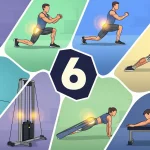Hey Fit People, Ever felt that rush of adrenaline while waiting for your turn in a futsal match with your office squad or campus crew?
Or maybe you’re already a regular at intercampus tournaments? No matter your level, here’s the truth futsal isn’t just a hobby, it’s an investment in your health.
But wait what exactly is futsal? How is it different from regular football? Is it healthier? And is hitting the gym really that important for futsal players?
Relax, we’ve got you covered. Let’s dive into it—all explained in a fun and casual way.
What Is Futsal and How Is It Different from Football?
Futsal comes from the Spanish and Portuguese terms fútbol sala or futebol de salão, meaning indoor football.
At a glance, futsal looks like a mini version of football. It’s shorter in duration, smaller in field size, and played by 5 players per team on an indoor court ranging from 375–1050 square meters. No need to worry about rain or blazing sun futsal is weather-proof!
The game was developed in 1930s Uruguay by physical education teacher Juan Carlos Ceriani. He combined elements from several sports:
- 5-player format from basketball
- Field and goal size inspired by handball
- Goalkeeper rules from water polo
The result? A fast-paced, high-intensity sport that demands technical skills and rapid decision-making.
As futsal gained popularity, FIFA officially embraced it and it took off globally for one simple reason, you don’t need a big team to have big fun.
Key Differences: Futsal vs Football
| Feature | Futsal | Football |
|---|---|---|
| Team size | 5 players | 11 players |
| Field | Indoor, small | Outdoor, large |
| Duration | 2 x 20 minutes | 2 x 45 minutes |
| Ball | Size 4, heavier | FIFA standard, Size 5 |
| Substitution | Unlimited | Limited |
With tight spaces and a faster tempo, futsal requires quicker reactions and sharper ball control.
Benefits of Futsal for Physical and Mental Health
If you think futsal is just for fun, take a look at this:
1. Stronger Heart
The fast, dynamic play forces the body to keep moving, increasing heart rate and blood flow. This makes futsal a powerful natural cardio exercise that effectively maintains heart and blood vessel health.
A study from the British Journal of Sports Medicine states that intermittent sports like futsal (fast-slow bursts) are effective in lowering blood pressure and strengthening the cardiovascular system.
2. Improved Response and Focus
In a small field, you have to think quickly, anticipate opponents, and find any available space. This trains the brain to think tactically, improve reflexes, and sharpen concentration.
3. Enhanced Coordination & Agility
Controlling the ball with your feet, while moving and dodging, makes your body coordination work extra hard. Quick left-right movements also train your agility.
4. Stress Buster, Mood Booster
Exercise releases endorphins (happy hormones) that make you feel relaxed and satisfied. Playing futsal with friends? Double the joy!
5. Burns Calories Quickly
With high intensity and short breaks, the body continuously burns energy. Playing futsal for 30 minutes can burn 250–400 calories, depending on body weight and movement intensity.
Futsal: Not Just a Hobby, But a Global Sport
FIFA officially started holding futsal tournaments in 1989 with the FIFA Futsal World Cup. Countries like Brazil, Spain, and Portugal have become global futsal giants. In Southeast Asia, the AFF Futsal Championship is also regularly held.
In Indonesia, we have the Professional Futsal League, and futsal communities are growing in universities, institutions, and even at the village level. This means opportunities for competing and developing are wide open.
Futsal Players Must Hit the Gym Too! Here’s Why
Now, this is rarely discussed. Many think training is enough on the field. However, if you want to be a powerful, injury-minimizing futsal player, adding muscle mass at the gym is a must.
Why?
- Futsal also needs Strength. You need leg strength for short sprints, shooting, and body charges.
- A strong core equals movement stability, especially when dribbling and defending.
- Resistance training at the gym helps build muscle, strengthen joints, and speed up muscle recovery.
- Programs like squats, deadlifts, leg presses, and agility drills help players become faster, stronger, and more agile.
According to research published in the Journal of Strength and Conditioning Research, a combination of futsal and resistance training significantly improves anaerobic performance and leg muscle power in young athletes (Faude et al., 2013).
If you’re confused about where to start, don’t worry, at Grand Focus Fit, there are training programs suitable for futsal players and beginner athletes. You can join the gym directly and consult with professional trainers.
Conclusion: Futsal is Fun, But Must Be Balanced
Playing futsal is fun, healthy, and competitive. But don’t just chase wins or style points. For maximum performance, combine futsal training with targeted gym workouts.
Do you want strong endurance, run faster, and avoid easy injuries? It’s time to make the gym your “second field.”
Come, join training at Grand Focus Fit, the best gym for those who want to be an excellent futsal player, even excellent in front of your crush! 😄
Sources:
- Harvard Health Publishing – Calories burned in 30 minutes for people of three different weights
- FIFA.com – Futsal History and Development
- Faude, O., Roth, R., Di Giovine, D., Zahner, L., Donath, L. (2013). Combined resistance and futsal training improves short sprint and power performance. Journal of Strength and Conditioning Research
- Ministry of Youth and Sports, Indonesia – Futsal Regulations & National Leagues





